Search results
9 results found.
9 results found.

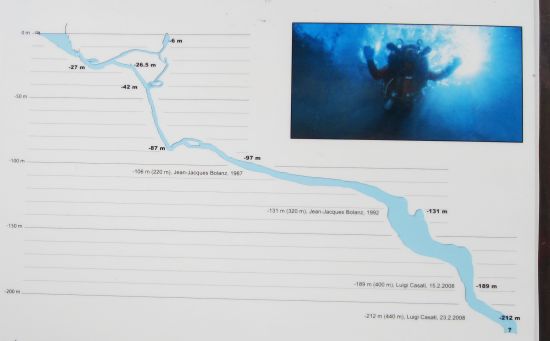
The silence from my end has been too long and also not explained. I can’t do anything about the length (except to break the silence now and stop the clock), but I can explain.
I’ve been in a car — how un-Venetian — with some friends for a week, stravaging around northern Italy from Milan to Pordenone and down to Venice. They were here from Virginia to watch their son play some soccer matches against their Italian counterparts.
This trip gave me a chance to visit, if only briefly, plenty of places I’d never been, several I’d never even heard of, only one of which I’d ever really wanted to see (see photo above), and also the chance to stand interminably in the rain on the muddy sidelines of even muddier soccer fields.
The Veneto has just been through the rainiest March in 20 years — three times more water fell everywhere than is usual. The vintners can’t prune their vineyards, the artichokes are a month behind, and the boys who ran and slid around drenched by the frigid deluge can tell you that they discovered a degree of wetness which nobody, not even skindivers, has ever experienced.
As for our itinerary, “We past through some of the damdes plases ever saw by mortel eyes,” as a Confederate soldier put it in a letter home. At the top of the list is the Hotel Antares in Villafranca di Verona. If you’ve ever wondered where the occupants of UFO’s go when their intergalactic aircraft run out of fuel, I can give you the address.
Now that I’m back and most of the laundry has been done, I confess that I feel very little urge to write anything about Venice at the moment. Catching up with the news here over the past few days has subjected me to a downpour, so to speak, of non-news even more monotonous than the record rain (see above).
What’s been happening in the most-beautiful-city-in-the-world is what has always happened, and what, apparently, ever will happen. By now it appears that there’s hardly any point in mentioning current events, because the same stories will keep turning up every week till Jesus comes back.
The procession of news by now is so repetitive, and so demoralizing, that the 1.20 euros we spend for the daily Gazzettino have become a sort of charity contribution to keep it in business. The national chronicle is stuck in an endless loop of the same names and the same chicanery, and the local reports form one interminable droning chorus about as interesting as singing “Ninety-nine bottles of beer on the wall.”
Classic themes: The constant deterioration of the city — palaces, churches, and bridges are falling to pieces, sometimes near or even on the heads of passersby, and the snaggly paving stones are so untrustworthy in some places that they trip as many people as they can each day and then snicker because they know they’re not going to be punished. There is the phenomenal inefficiency of the public health service. The occasional little old person found dead in his/her home after days/weeks/months. The closing of generations-old stores that can’t pay the insane rent increase, which has typically been raised in order to install yet another glass/mask/pizza-by-the-slice business. These shops sell glass and masks as being made in Venice, which in a sense they are; not by Venetians, though, but by swelling numbers of Chinese immigrants who toil in sweatshops and live in little mainland hellholes.
If you tire of those stories, you can always read about the spectacular mismanagement, in myriad and ever-more-imaginative forms, of the public transport system. It’s amazing how many ways the ACTV finds to throw away money it insists it doesn’t have. And tomorrow there will be yet another transit strike: no buses, no vaporettos, a 24-hour dislocation of life which will produce no results. So there will have to be another one.
Speaking of money, it continues to gush, like water from a busted pipe, out of the Venice Casino, which once was one of the top three contributors to the entire city budget. Then there are the pitiful protests, as tiring and pointless as the wailing of a baby with colic, against the big cruise ships — “pitiful” not because I agree or don’t, but because cruise ships are now such a crucial part of the municipal economy that driving them away would kick the last leg out from under the tottering financial stool of the city’s economy. And “pitiful” because all the schemes which have been proposed to solve this so-called problem will create real, tangible, measurable problems for all eternity.
To sum up, the news from here is a ceaseless litany of the same issues, the same excuses, the same inertia, the same blithe, extravagant, “who, me?” waste of everything including now even my patience and my curiosity.
Oh: And the “Boy with the Frog,” claimed to be scheduled for removal on March 18? It’s still standing there. I let myself get excited by what sounded like a real decision, and now I’m embarrassed. I evidently had more hope than good sense, even after all this time.
If I were a reporter for the Gazzettino, I’d write my stories sitting at home in my underwear listening to old Janis Joplin tracks. I’m not saying anybody actually does that. But they could.
The only interesting thing I’ve heard in a week was about the ten-year-old boy who snuck out of his house in the middle of the night in his pajamas to go smash the window of a toy store with a brick in order to get his hands on the thing he wanted that his parents had refused to buy for him. That was different! But it wasn’t in Venice — it was in Vicenza.

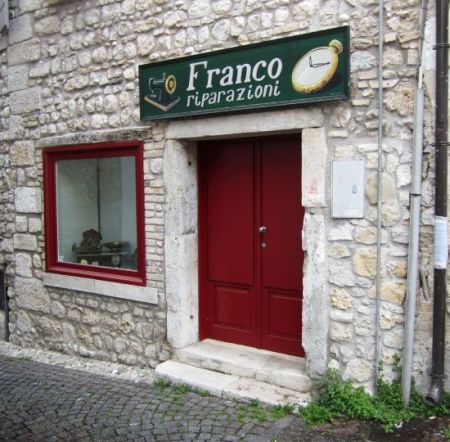



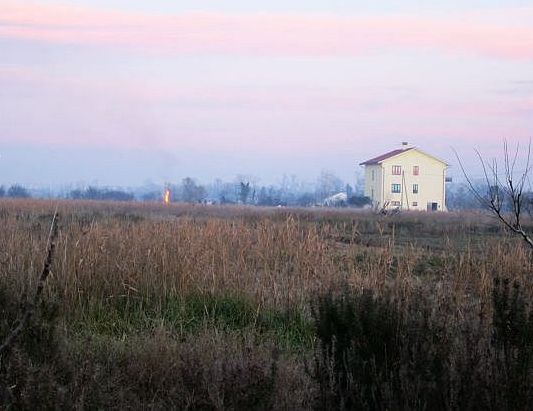
Last Saturday night, while you were doing whatever you do, we were on Sant’ Erasmo participating in a wild pagan ritual. It’s known as panevin (pahn-eh-VEEN)or, more simply, brusar la vecia (broo-zahr ya VEH-cha — burn the old woman).
I’ve experienced it many times from a downwind distance, inhaling the smoke of many faraway bonfires, but three days ago was the first time I ever participated. The Finotello family, whose market garden Sapori di Sant’ Erasmo has long since become our favorite produce store, told us they were going to be burning the old lady and sure, we could come too.
We always row over in a mascareta, partly because it’s a great motivation to go rowing, and also, not incidentally, the boat makes it easy to bring back our kilos of cauliflower or cabbage or tomatoes or eggplant or whatever’s good that day.
So around 4:00 we wandered across the span of lagoon between Castello and Sant’ Erasmo, threading our usual path along the flank of the Certosa and Vignole islands. The sun was going down, and it felt a little like we were sneaking out of the dorm after curfew, to be going out at the time we’re usually heading home.
I’ve written at other times about the history of this prehistoric practice, which is especially at home in the Northeast of Italy, so I’ll limit the scholarly details. It’s enough to remember that the effigy represents the old (year, primarily) and therefore must be extinguished as a propitious start to the new (year, of course); that it’s an excellent way to dispose of the year’s prunings, which would have to have been burned eventually anyway; and that it’s a great excuse to end the holiday season with a party that also can keep you warm.
Needless to say, people in Mestre complained about the smoke (I say “needless,” because nothing happens here without some wail of protest from somebody, including me). It wasn’t the fumes from Sant’ Erasmo that bothered them, but from various places close to the city. Unbreathable air! We had to stay shut in our houses with all the windows and doors sealed! Call the fire department, something’s burning!
I give a little slack to people with genuine pulmonary issues, or anyone who might have encountered smoke caused by burning rubber or plastic.
Otherwise, here’s my message to the good burghers of Mestre: Get over it.
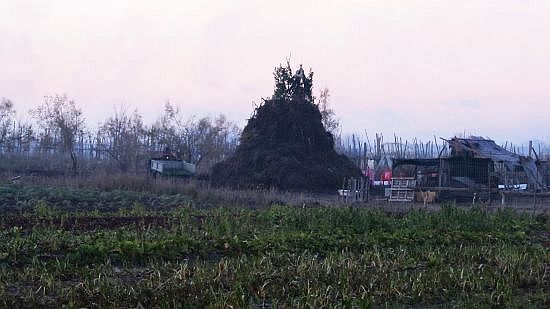
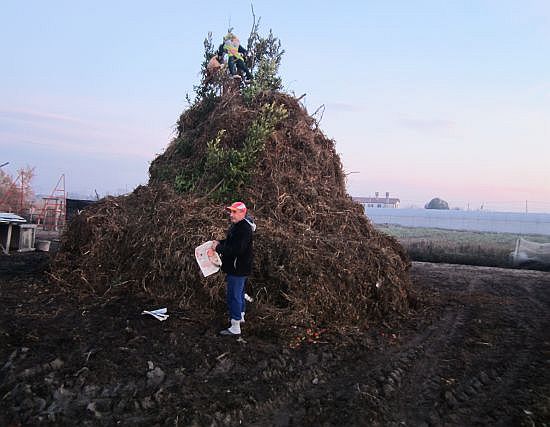

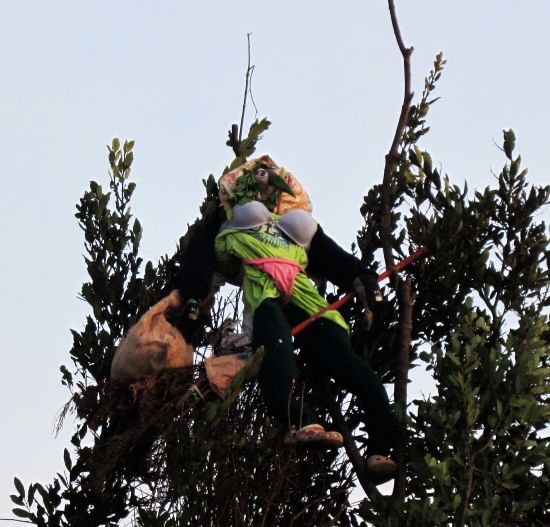
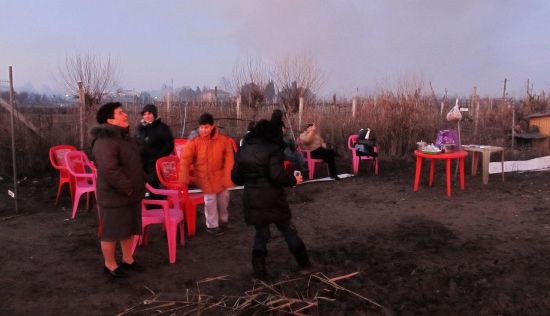

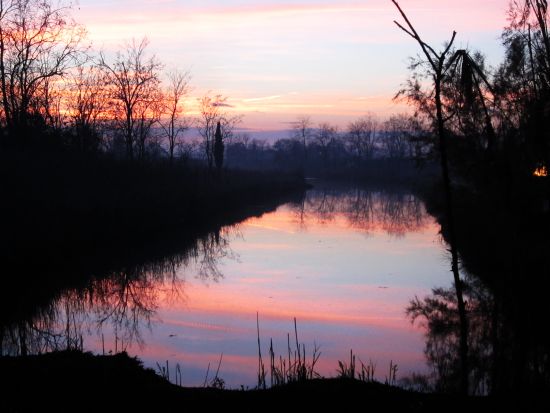
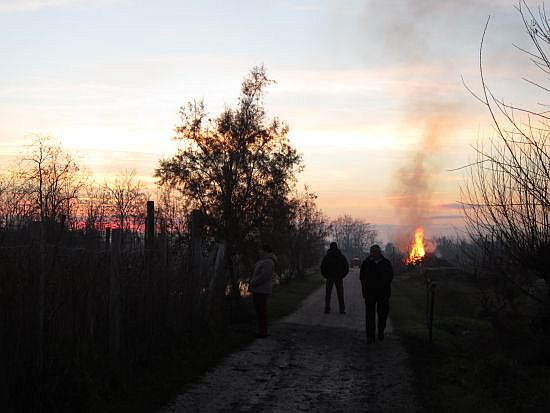
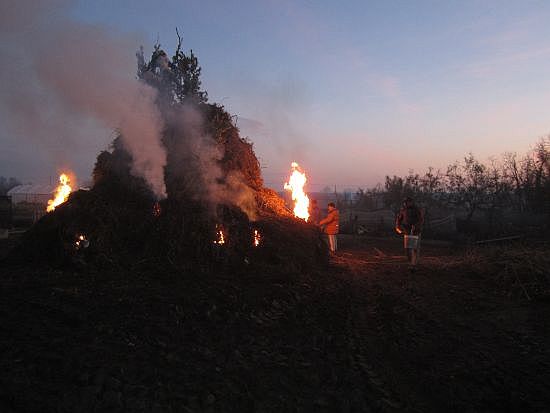



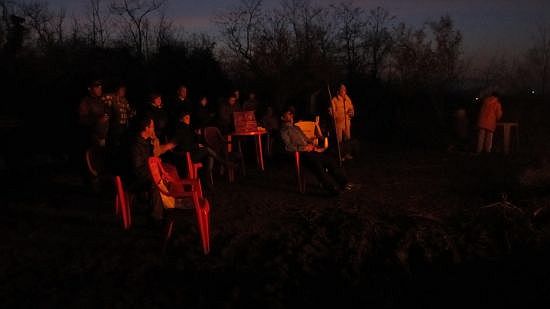
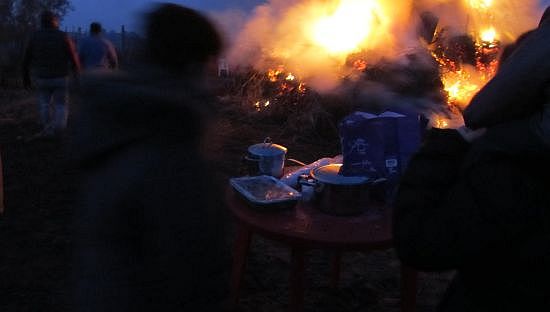
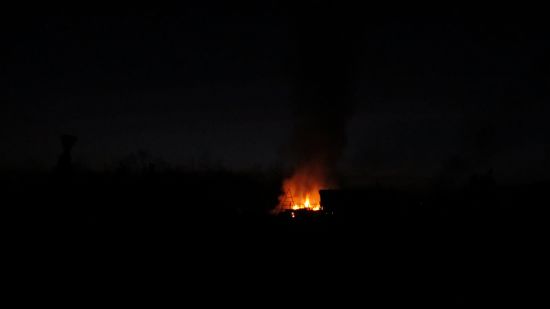
But the blaze wasn’t the only beautiful experience that evening. We got a massive bonus with the row home in the dark. I suspected we would, because we often used to row at night. But years have passed since our last “notturna.”
The lagoon isn’t ever ugly, but it’s like Gloria Swanson — at some moments it’s more beautiful than at others. At noon on a summer Sunday you will not see it at its best.
At night, though, and especially in the winter, it is a place of deep, luminous glamour. The silence, the stillness of the water, the sense of space, the stars, the cold — all the components join to make something much greater than the whole.
I didn’t even try to make any photographs because I knew they would never show what was really there. The barely perceptible movement of the water’s silky surface responding to the oars, which I could sense in my hands and then, from the bottom of the boat, through my feet; the small sound of the oars themselves, slipping through the water and occasionally squeaking against the humid wood of the forcola; the frigid damp of the oar chilling my bare fingers. The coldness of the air that I could breathe all the way down to the bottom of my lungs. The bright white dot of Venus reflected in the water, which floated next to us all the way home on our port side, bobbing back up after every stroke. The misty beam of the lighthouse on Murano shining straight out to sea through the inlet at San Nicolo (4 flashes, 2 seconds pause) and the unexpected way that it appeared closer to us at one point, then five minutes later seemed to be miles away, even though the physical distance had barely changed.
A mere two miles (3.6 km) from the bonfire to our house felt like some pilgrimage suspended in time. In the dark, the lagoon seemed untethered from everything that wasn’t it. No longer was it the plodding, workaday lagoon, the watery equivalent of an enormous Wal-Mart parking lot forced to marry an interstate interchange, but something whole, completely itself, majestic, complex, lacking nothing, needing nothing.
We crossed the Canale delle Navi by the Arsenal and rowed down the rio di San Pietro. Boats, walls, houses, windows, but no people. It was only 7:00 PM and there wasn’t even the sound of a person. We turned into the rio di Sant’ Ana — deserted. Nobody on the fondamenta. Nobody on the bridge. Silence. It was eerie. Beautiful, I guess, but it was as if the lagoon had just let itself go and obliterated everybody but us.
But of course, it hadn’t. At the end of the canal we could hear the Saturday-evening-going-home cacophony. Men shouting, dogs barking, kids wailing.
We now return you to your regular dimension.
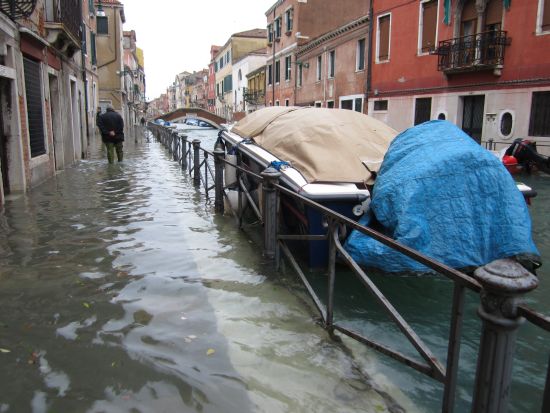
Saint Martin’s day yesterday was a lot more emphatic than it usually is with the banging of pots and pans by kids on a quest for candy. In addition to the kids, and the traditional cookies, we got acqua alta — the second visitation of the season, and it was noticeable. The news tonight reported that it had reached 149 cm (4.8 feet) above sea level, the sixth highest since 1872. (The highest on record remains November 4, 1966, which was 190 cm/6.2 feet).
Water didn’t enter our hovel, but it didn’t miss by much.
We heard the sirens sound, as expected, two hours before the peak predicted for 8:20 AM. There were three extra tones, which indicated an anticipated maximum of 120 cm (3.9 feet). Not long after that, we heard the sirens again, this time with four tones (140 cm/4.5 feet). At that point we sat up and began to pay attention.
What made this event more interesting than usual wasn’t simply the height of the water, it was the speed of the wind — I mean, the force of the scirocco, which is always a major factor in keeping the lagoon in when it wants to go out. The wind was blowing around 40 km/hr (24 mph), with gusts of 55 km/hr (34 mph).
All this was part of a major weather system that hit large areas of Italy leaving real drama and destruction in its wake — mudslides, blocked roads, fallen trees, and more mayhem than we could ever manage here, thank God.
Naturally we went out to buy the newspaper and look around the neighborhood. I don’t usually take pictures of acqua alta anymore, as they have long since become repetitive. But this was toward the unusual side of the daily scale of nuisances.
Of course I’m glad the water didn’t exceed our top step, but if it had, I’d still be alive. This is the first of my annual pleas to the world to ignore the wailing and gnashing and published or broadcast claims that the city has been driven to its knees. I do not consider the fact that a tourist has had wade across the Piazza San Marco carrying her suitcase on her head an indication of anything larger than a temporary annoyance — it certainly does not make even the tiniest wail begin to form anywhere in my thorax. Anyone who has been dealing with Hurricane Sandy and its aftermath — not to mention people in stricken areas of Tuscany and Umbria — would find the suggestion that a large but temporary inconvenience could be compared to life-threatening catastrophe not only ridiculous, but offensive. By noon the water was all gone and the streets were drying off.
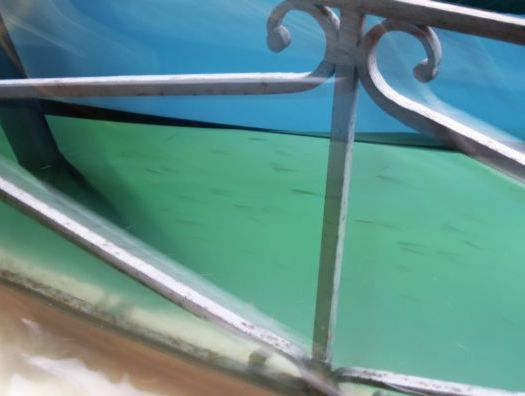
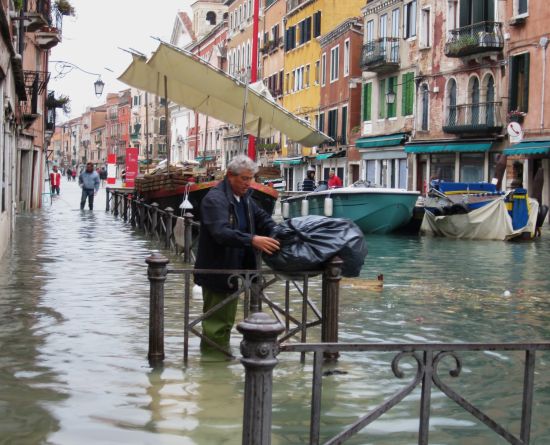
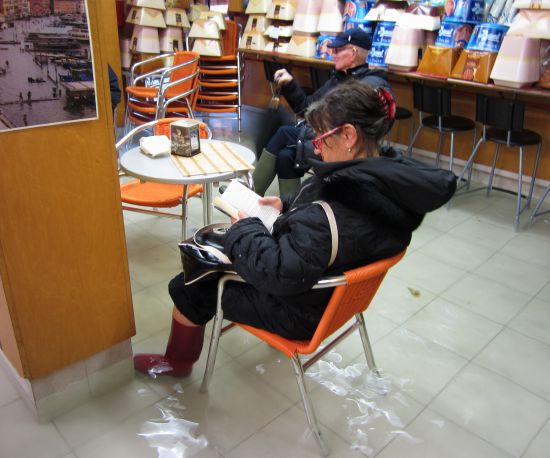
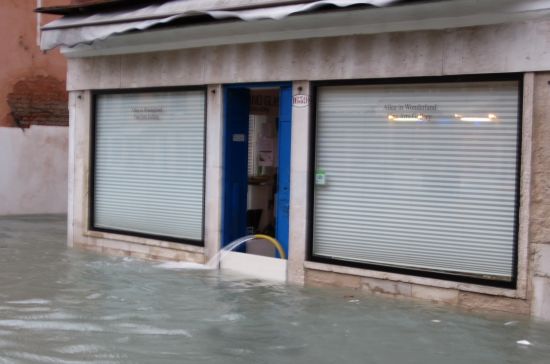
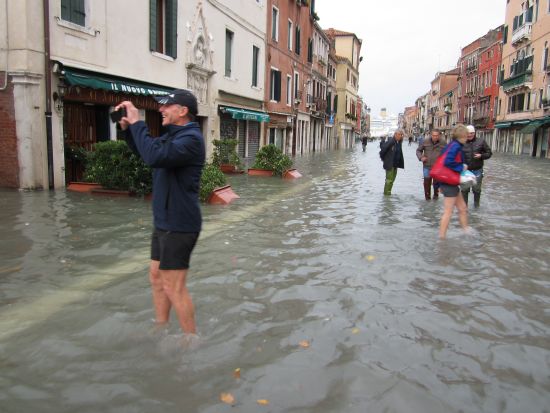
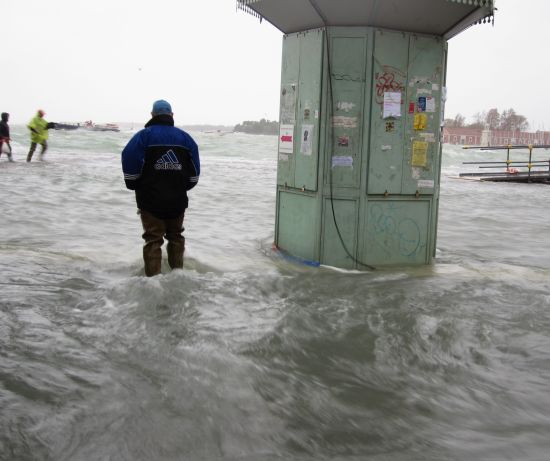

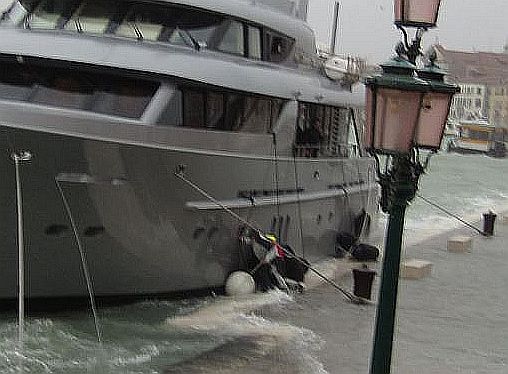

It’s probably way past everybody’s bedtime, so I’ll wrap up this little philippic.
Imagining momentarily that a satisfactory conclusion could ever be reached in the Gordian convolutions of the “floodgate” project, permit me to make a few very brief observations.
First, let us make a concerted effort to ban all those irresistible emotional words that acqua alta seems to force from journalists’ subconscious. “Venice under siege,” is a common one. CNN said that the high water of December, 2008 had been caused by the Adriatic “bursting its banks.” (Banks? Bursting? Are we in Holland?). The Discovery Channel stated that the high water was “cannibalizing” the city’s buildings (OMG). And on and on. One could smile if this kind of reporting wasn’t cannibalizing common sense.
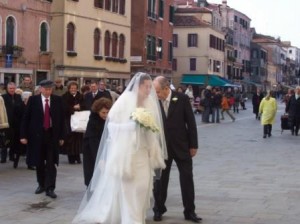
When I think about it really calmly, it appears to me that it’s actually impossible for the planners and builders of MOSE to be able to make any promise (guarantee, statement, claim, whatever you like) about their creation that they can prove is accurate.
There are simply too many unknowns in the many different scenarios devoted to its use: How well it will function — that’s the big one — how much its maintenance (routine or extra) will cost, where the money for feeding and caring for it will come from, etc.
Every claim from its proponents is supported so far only by data assembled by them.
Probably the two major areas of concern for its success are:
First: How high the highest tides are likely to become. Some estimates only give MOSE 100 years of usefulness, after which the highest tides will spill over its maximum height. The frequency and duration of these exceptional high tides are also subject to interminable debate. But nobody knows.
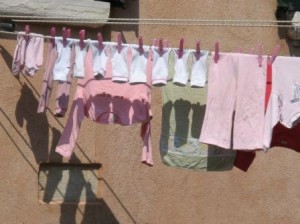
Second: How well the individual caissons will remain aligned. As I mentioned in my last post, if they begin to lose their perfect uniform surface (even if only one of them doesn’t rise as high as its neighbor, or the seal begins to leak), the strength of the entire “wall” of caissons will be compromised.
I have rowed against the incoming tide at the inlet at San Nicolo, in normal weather with no hint of wind or surge, and it is nowhere near being a joke. If the barrier isn’t perfect, the tide will come in whether MOSE is ready or not.
But let us not be downhearted. Let’s say that the machinery functions perfectly, precisely as planned. Let’s say that exceptional high water occurs ever more frequently. as expected. Let’s say that every prediction is fulfilled, even though there is no way to assume they will be.
Here is the real question: Has Venice been saved from anything except some water in the street for a few hours?
The true inundation, the most implacable and destructive, is the endless tide of tourists. The number increases 3 per cent every year; in 2009 it reached 21 million in an area of about three square miles.
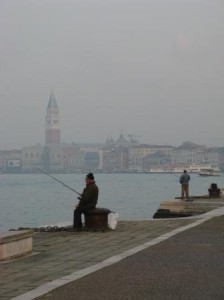
Whether this fact inspires emotion or not, it is more measurable, and predictable, than the inexact, politically driven “science” that has given birth to MOSE.
So let’s say that while assorted interested parties continue to water and fertilize the popular obsession which the press has with acqua alta, some very real problems continue to be neglected.
Young families will continue to move away because they can’t afford Venice (housing, primarily, though lack of jobs is a close second), the older generations eventually die off, and before MOSE has become obsolete the city will be devoid of residents. In their place will be the tsunami of tourists — tended to by merchants who mostly live on the mainland — which will finally render the city completely unliveable.
So even if MOSE performs perfectly, the Venice that has been “saved” will amount to nothing more than a collection of really old buildings, beautiful or not, according to your taste.
If no comparable effort is made to revive and protect the life of Venice, then even if MOSE turns out to be an engineering marvel to rival the invention of the arch, the once-thriving city will be as devoid of life as Machu Picchu.
When that happens, there’s won’t be much point in vilifying MOSE, or bewailing the triumph of politics and fear over basic municipal common sense.
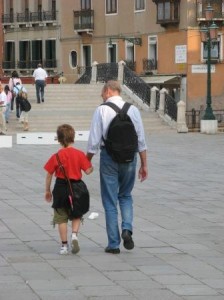
But it seems clear, even now, before the first button is pushed, that if the time, energy, and billions of dollars that will have been spent to hold back the tide had been dedicated to resolving the chronic, debilitating problems that Venice experiences every day, in 50 years there would still be a living city worth saving.